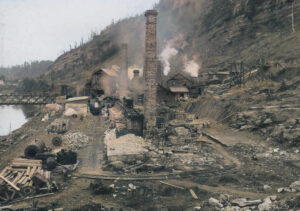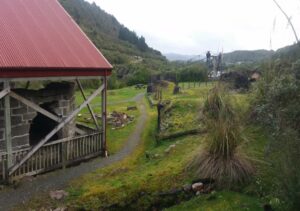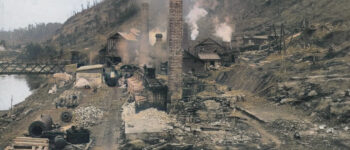1864: Coal on the Coast
July 28, 2023
By AHNZ

Today in New Zealand History, 28 July, 1864, the first cargo¹ of the great West Coast coal supply chain was shipped from Greymouth. It was preceded only by Captain Moore’s 50 tons in 1840 collected from near Farewell Spit and taken to Wellington. The 1864 coal came from what would soon become Brunner Mine and the site of Brunnerton (aka Brunner) which itself became the town seat of the Borough of Brunnerton (1887-1971.)² Brunnerton is a ghost town these days but with lots of interesting industrial relics. In its day Brunnerton partly existed in Nelson and partly in Westland since the Grey River was the provincial boundary. William Fox apparently tried to stamp the name Cobden Coal Mine on the place in c.1875 but that didn’t stick. Ref. 1872: Cobden Coal Mine
Entrepreneur Reuben Waite had come to that vicinity on 22 June, 1864, on the steamship he chartered, S.S. Nelson. Waite brought stores to sell, 70 gold-seeking diggers, Mr Matthew Batty (miner,) and some Maori workers. Waite also loved cats and had 10 of them! If no gold was found then Waite would sell none of this cargo but he had covered his bet with a contract to the Nelson Provincial Government for 40 tons of coal from the Brunner site.
That coal had been discovered by Thomas Brunner in January 1847 with 14 Maoris and the use of 4 canoes. The world thought Brunner had died on this expedition but he made it back to Nelson alive as would Reuben Waite who was also rumored to have died on his trip. 20 Years later, in 1864, and in the same way, Matthew Batty set out by canoe with his own Maori helpers. “This was then conveyed down the river to the Grey, where on July 28th, 1864, twenty-seven tons were placed aboard the S.S. Nelson, and shipped from what we now know as Port Greymouth.” Ref. Lord (e1976)
Batty’s coal was also ignited back down-river for a large evening fire for those gathered. The fire would not only be a celebration of mining and entrepreneurial success but also a great way to keep warm on a cold June night which could easily have been cold enough for a frost. However, things were not going quite so well at this point for the Mr Waite. He came to the fire afraid for his life because the first diggers had found no gold at all and blamed him. This was the very beginning of the gold rush, ground zero, although it had been expected since James Mackay bought the West Coast 4 years prior. Ref. 1860: The West Coast Purchase
 The Entreprener, Waite, (from Nelson Province,) was re-establishing the store on the Grey since his predecessor Charles Townsend (Canterbury Province) had drowned in the line of duty while attempting to cross the Grey Bar in October of the previous year. Waite never promised anyone gold or asked the diggers to come, they had ‘pleased themselves.’ Finding none, the diggers were ready to kill someone. It turns out that the reason the expedition found only Maori women upon arrival was that all the Ngati Waewae men had already commenced collecting gold at what would become the first digging and town: Greenstone. This must have included their old chief, Tainui. The Maori men were striking it rich and, determined to keep their gold coming, misdirected the newcomers onto useless ground at the Taramakau river and completely blocked up the track to Greenstone! Such was the explanation Waite discovered later for why a lynch mob had formed up to hang him! When he made it back to Nelson alive the public were surprised as word had already made it ahead of him that he was a dead man.
The Entreprener, Waite, (from Nelson Province,) was re-establishing the store on the Grey since his predecessor Charles Townsend (Canterbury Province) had drowned in the line of duty while attempting to cross the Grey Bar in October of the previous year. Waite never promised anyone gold or asked the diggers to come, they had ‘pleased themselves.’ Finding none, the diggers were ready to kill someone. It turns out that the reason the expedition found only Maori women upon arrival was that all the Ngati Waewae men had already commenced collecting gold at what would become the first digging and town: Greenstone. This must have included their old chief, Tainui. The Maori men were striking it rich and, determined to keep their gold coming, misdirected the newcomers onto useless ground at the Taramakau river and completely blocked up the track to Greenstone! Such was the explanation Waite discovered later for why a lynch mob had formed up to hang him! When he made it back to Nelson alive the public were surprised as word had already made it ahead of him that he was a dead man.
The Ngati Waewae’s deception was eventually discovered and footprints followed to the gold at Greenstone. In the meantime the Maoris evidently had a sense of justice and did not want Waite to have to pay with his life for their ruse. So, they backed him against the mob along with others and forewarned him. Waite wrote “…there would have been bloodshed that night had the diggers interfered with me…” and an Irishman kindly said “Cheer up, my boy, don’t be frightened, you have more friends than enemies in this crowd.” Ref. (Lord (e1976) quoting Waite (1869)
“Work at the mine was first commenced in the year 1864 by Matthew Batty and party, who were the first to lease it from the Nelson Provincial Government. Subsequently, a company from Ballarat, in Victoria, worked the mine for about four years, when its lease was cancelled. The property was then worked for some years by the Provincial Government itself, and in 1874 a lease was granted for twenty-one years to a Melbourne firm..”
“The borough of Brunnerton… There are four churches…three State schools…Mails arrive from different parts of the coast four times daily, and the post office is rated third class. Brunnerton has a Masonic Lodge—Lodge Advance, New Zealand Constitution—and a lodge of the Order of Druids. Brunnerton is connected by railway with Greymouth and with Reefton, about thirty-eight miles distant. At the census of 1901 it had a population of 1572 souls.” – The Cyclopedia of New Zealand (1906,) NZ Electronic Texts Collection, Victoria University
“…in 1870 the Nelson provincial government took over the mine. It thus became the first State-owned coal mine in New Zealand and, after completion of the railway in 1876, was soon producing a sixth of the nation’s coal.” – New Zealand’s Heritage (1971)
“On July 28, 1876, a cold, frosty morning, Brunnerton was shaken to its foundations by the collapse of the bridge, which fell like a pack of cards into the river. The noise made was heard for miles around. The “king frost” was responsible for the disaster, the anchors on the south side, holding the supporting ropes of the bridge, snapping like carrots. The bridge was nearly completed and luckily the men had not started work, no lives being lost. It was contended that the anchors should have been buried in concrete to withstand the frost. The bridge was again erected, and still spans the river at Brunnerton. Within the past few years the top deck was removed, and repairs were effected to make the structure safe” – Grey River Argus (1940,) Papers Past
“The decision to close Dobson before it was worked out may be seen as an enlightened one by some future generation. For there is little doubt that the resource could be put to better use than it was. In 1928 Chris Davis, a member of the syndicate which opened Dobson Mine, expressed a vision of the coal’s future role as a precious commodity. “Dobson coal is exceptionally rich in by-products, and the time will come when coal of this class will be too valuable to burn in the ordinary way…New Zealand will be independent of overseas countries for the supply of its oil and motor fuels. Its wealth of coal will supply these requirements.” Forty years later, just before the Dobson closure was announced, Greymouth historian Oswald Jackson was thinking along similar lines. Reviewing the coal- versus-oil struggle, he asked: “Will this or future generations decide the issue? One thing is certain this bounteous supply is too valuable an asset to leave untouched, and the utilisation of coal for many world-needed products must at some time be proceeded with, eg., carbon black, plastics, petroleum, etc.”…The coal awaits.” – Unspent Energy, Les Wright (1988)
 So, the gold and coal were on and Waite’s venture paid off. S.S. Nelson’s service between Nelson and Greymouth became regular as Greymouth and the West Coast opened up and boomed. Long after the gold died down the coal kept coming and especially from Brunner thanks to its great river access. Brunner Mine expanded to large scale industrial activity thanks to the capital and technology of the British Empire. New Zealand was now producing its own coal rather than having to import it from Australia. The scale of the operation had, in 1896, death and disaster to match. Ref. 1896: Brunner Mine Disaster
So, the gold and coal were on and Waite’s venture paid off. S.S. Nelson’s service between Nelson and Greymouth became regular as Greymouth and the West Coast opened up and boomed. Long after the gold died down the coal kept coming and especially from Brunner thanks to its great river access. Brunner Mine expanded to large scale industrial activity thanks to the capital and technology of the British Empire. New Zealand was now producing its own coal rather than having to import it from Australia. The scale of the operation had, in 1896, death and disaster to match. Ref. 1896: Brunner Mine Disaster
It’s a very good thing that Brunnerton had close access to coal because it was a very, very, cold place to live. The Grey Valley, in this spot, narrows down and forces an aerial river locals call The Barber. Throughout the early morning, especially in winter, the persistent breeze of frigid air flows down-river just above the Grey River itself. Nor does Brunner get a very long day of sunlight due to this valley being situated north-south. Matthew Batty’s operation used barges to get to port which had to be hauled up-river by pony but by the 1870s the government had taken over and installed a railway including a bridge. On 28 July (exactly 12 years after Batty’s first coal export) the morning was so cold that the new bridge ‘snapped like carrots’ and came down!
Brunnerton was once as prominent as Hokitika and Greymouth and when Governor Grey came to the West Coast he consulted all 3 mayors. It could be a powerhouse again if we wanted to go after the coal that’s still down there but otherwise it sleeps and we import inferior coal from overseas. In its best days Brunnerton was not only a powerhouse of the Colony of New Zealand but an essential strategic asset to Britain in this part of the world in the age of steam³.
—
1 Ref. p1065, New Zealand’s Heritage (1971)
2 The Borough was apparently legislatively abolished by its own request in 1925 but this wasn’t acted upon Ref. Press (1925,) Papers Past and Brunner Borough Abolition Act 1925, NZLII
3 Since coal can be made into petrol there’s no reason why the importance of Brunner would need to be confined to the age of steam though
note: “That Commission…accordingly reported against taking any further steps towards abolition. The matter was therefore not proceeded with.” – DEPARTMENT OF INTERNAL AFFAIRS ANNUAL REPORT (1927,) AJHR, Papers Past
Image ref. c1900, New Zealand Government Tourist Department : Brick and tile works at Brunner, West Coast. Alexander Turnbull Library; Colored up by AHNZ (2023)
Image ref. Brunner the ghost town, AHNZ Archives (2023)
Image ref. Post Office, Brunnerton (later known as Brunner). Photograph taken by William Archer Price between 1909 and 1912. Alexander Turnbull Library
Ref. Old Westland, Edward Lord (e1976)
3 thoughts on "1864: Coal on the Coast"
Leave a Reply
 Like Comment Share
Like Comment Share






I’m glad someone has exposed the history of some of West Coast coal mines.
How important they were to this regions development and the role the coal played in our countries development.
Also the potential bye products that can be made from coal.. There is a huge potential out there if only politians will listen before they act by passing negative registration!
There are endless supplies of coal here .not even touched. Eg Mount Davey. Spring Creek Dobson coal seam stretches from Ikamatua to Ross. The Pike River has only been started. But time will tell if that ever starts again. Then there as another coal feild near Haast.
The West Coast has the infrastructure to shift volumes of coal. Eg rail systems and2 ports and Lyttelton as well . .
All it takes is some one with determination and foresite
Thanks; Hope to write more in future on same topic. I’m amazed at what was once at Brunner and it shows me that a community requites an economic base. Take away the productivity and the civitas melts away.
To get it back surely we need Anarchism? If Westland were a Province again it could call its own shots. National politics is a very long way off from ‘permitting’ the Coast to industrialise again. It’s not in the interests of politicians to support such a thing. Indeed, they’re probably doing deals with people offshore to make sure we don’t compete in “their” markets.